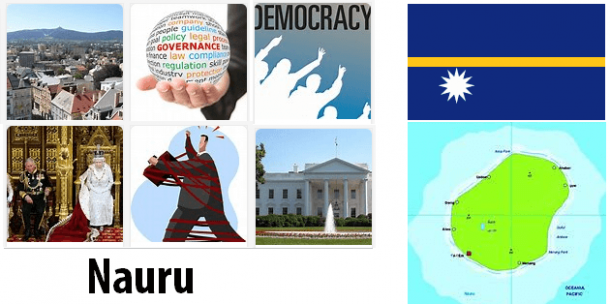Nauru Government and Politics
State and politics

The legislative power of Nauru is held by a parliament with 19 members and a term of office of 3 years. It appoints a president, who is also the head of government. Since 1987 there has been a political party, the Democratic Party of Nauru, in addition to various tribal organizations. However, the policy has revolved around individual politicians. When Hammer DeRoburt, Nauru’s supreme chieftain who dominated politics since 1968, was deposed as president because of power, his main rival, Bernard Dowiyogo, was appointed as a successor and re-elected in November 1992. characterized by instability.
Former Australia Defense Force, which manages Naurus’ foreign and defense relations, has been required for damages for environmental damage from the income-generating phosphate mining. At the same time, Nauru has become more dependent on financial support from Australia, as income from phosphate mining has decreased as assets decline. Nauru is a member of some of the UN sub-bodies (not the UN) and a special member of the Commonwealth.
Judiciary
The highest court in Nauru is the Supreme Court. The legal order is based on the reception of English law, but inheritance law and the right to land are determined in accordance with local customary law. The death penalty remained in the legislation until 2016, but was de facto considered abolished since the country became independent in 1968.
Heads of State
Presidents
| 1968-76 | Hammer DeRoburt |
| 1976-78 | Bernard Dowiyogo |
| 1978-89 | Hammer DeRoburt |
| 1989-95 | Bernard Dowiyogo |
| 1995-97 | Lagumot Harris |
| 1997-98 | Kinza Clodumar |
| 1998-99 | Bernard Dowiyogo |
| 1999-2000 | Rene Harris |
| 2000-01 | Bernard Dowiyogo |
| 2001-03 | Rene Harris |
| 2003-03 | Bernard Dowiyogo |
| 2003-03 | Then Gioura |
| 2003-03 | Ludwig Scotty |
| 2003-04 | Rene Harris |
| 2004-07 | Ludwig Scotty |
| 2007-11 | Marcus Stephen |
| 2011-13 | Sprent Dabwido |
| 2013-19 | Baron Waqa |
| 2019- | Lionel Aingimea |

NAURU. – Island of the Pacific Ocean, located at 0 ° 32 ′ lat. S. and at 166 ° 55 ′ of long. E. It was discovered in 1798 by Captain Feam and became a German possession in October 1888. Since 17 December 1920 it has been under the mandate of Great Britain, Australia and New Zealand. Of coral origin, with abundant volcanic soils, the island has an area of 20 sq km; it is flat and rises to a maximum height of 65 m. in a wooded hill located at the western end. The excellent climatic conditions favor the vegetation of the coconut trees. But the island owes its importance to the large deposits of phosphates (due to the decomposition of eruptive feldspars), with reserves estimated at 80-100 million tons. The exploitation is carried out by the Pacific Phosphate Company. Export from island is mostly made up of phosphates, with an average annual quantity of 300,000 tons. for the period 1928-1931, directed mainly to Australia and New Zealand. Add a certain amount of copra to this product. In imports, foodstuffs and manufactured goods prevail. The population in 1932 consisted of 141 Europeans, 1479 indigenous, and 696 Chinese, with a total of 2316 individuals. Maritime communications are carried out by ships of the Pacific Phosphate Company. There is also a marking station in Nauru. In imports, foodstuffs and manufactured goods prevail. The population in 1932 consisted of 141 Europeans, 1479 indigenous, and 696 Chinese, with a total of 2316 individuals. Maritime communications are carried out by ships of the Pacific Phosphate Company. There is also a marking station in Nauru. In imports, foodstuffs and manufactured goods prevail. The population in 1932 consisted of 141 Europeans, 1479 indigenous, and 696 Chinese, with a total of 2316 individuals. Maritime communications are carried out by ships of the Pacific Phosphate Company. There is also a marking station in Nauru.


